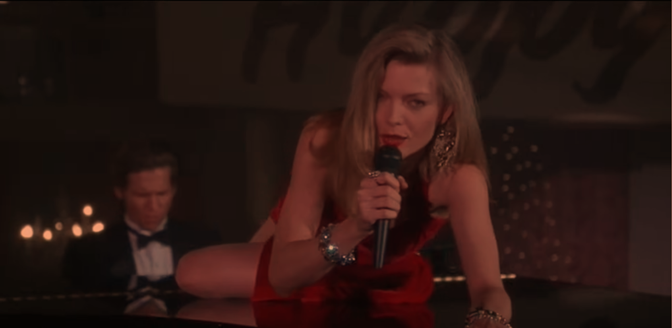
Of the great cinematic icons of the late-20th century, Michelle Pfeiffer remains a confounding enigma. Though bona fide movie star in the 1980s and 1990s, Pfeiffer always seemed overshadowed by her A-List peers like Meryl Streep, Jessica Lange, or Glenn Close. After her impressive run as a box-office superstar, Pfeiffer took several hiatuses throughout the late 1990s up until the 2020s, essentially dimming her star power. The roles she did take rarely engaged with her talent or charisma, and it felt like a lot of work she did in her post-superstar years was slumming it.
This month, Pfeiffer will turn 66. She has several projects lined up, including a Christmas comedy. Though we should reserve judgment, it feels a bit dispiriting that the woman who starred in Scarface, The Fabulous Baker Boys, and Batman Returns use her considerable skills on a holiday comedy. Though to be fair, the vague whiff of z-list has shifted as big stars sign on to make Christmas comedies, joining the has-beens or used-to-bes. If this film happens, Pfeiffer will have appeared in more than 50 films, including feature films and TV movies, working with some of the greatest co-stars in cinema, and being directed by some of the most important filmmakers of the 20th century. She’s appeared in several genres, excelling in period dramas, romantic films, musicals, and shining brightest in comedies. She’s also appeared in superhero films and fantasy films, stepping out of her ‘comfort zone’ and making her mark.
As an actress, Pfeiffer is always reliable to put in a spotless performance. That professionalism means that in some of her films, she can be underestimated. But in her greatest performances, she’s absolutely stunning. She has a sardonic, pained approach to her work, even the funnier roles. In her salad days in the 1980s and 1990s, she was an exciting performer, making audiences laugh, cry, and fall in love.
In ranking her work, I’ve focused only on her good performances. For a filmography as long and varied as Pfeiffer’s, there are some great films – classics, even – but there are some duds, too. She’s never been bad in a film, but in films like I Am Sam (2001) and People Like Us (2012), she’s merely very good. Not exciting, but competent. Many of her greatest performances – including some brilliant performances – have been slotted into films that were either merely fine, if not mediocre. So, this ranking isn’t of her greatest films but her greatest performances.

20. Grease 2 (1982)
This sequel to the 1978 classic nostalgia musical is doomed to fail, and for good reason. Grease wasn’t a great film but lasts because of its charm. Grease 2 doesn’t measure up. Without former stars John Travolta, Olivia Newton-John, or Stockard Channing, it’s up to a group of newbies to entertain audiences. And though they try, they come up short, with the notable exception of Pfeiffer. In all her early-career hotness, Michelle Pfeiffer is the epitome of cool as the gang leader, Stephanie Zinone. Director Patricia Birch fails for the most part, but does score mightily when showcasing the insouciant charm of her leading lady.

19. Into the Night (1985)
John Landis’ action comedy was an early indicator that Michelle Pfeiffer wasn’t just a gorgeous face, but also a funny lady. As the plucky jewel thief, Diana, the actress does a fine job in a busy and gaudy black comedy. Paired with Jeff Goldblum, she gives a spirited and loose performance that belies her movie star looks. Into the Night isn’t a good film, nor a particularly memorable one, but Pfeiffer makes her mark with an amusing turn.

18. Sweet Liberty (1986)
There was a time in the 1980s when it looked like Alan Alda was going to give Woody Allen a run for his money, as cinema’s ultimate comedy auteur. Less intellectual and ambitious than Allen, Alda’s oeuvre is perfectly serviceable mainstream entertainment. Sweet Liberty, the actor’s second feature as a director is one of his more clever efforts. Set on a film set in a small North Carolina town, Sweet Liberty is a behind-the-scenes showbiz comedy that benefits greatly from its clever script and beguiling performances, including Pfeiffer, who’s a breath of fresh air as the movie star, Faith Healy. There’s a smart duality in Pfeiffer’s work, as she is able to portray both sides of her character – the actress and her character – adroitly.

17. Scarface (1983)
Female characters are often subsumed in crime dramas, disappearing in the machismo bluster. In Brian De Palma’s cult classic, Pfeiffer makes her mark and holds her own, despite the powerhouse performance of star Al Pacino. As the glassy and self-possessed Elvira Hancock, Pfeiffer ably portrays the young woman’s ascent and eventual self-destructive descent into drug addiction, abuse, and rancour. The film’s cult status extends itself – to a lesser extent – to Pfeiffer’s work in the film, aided in no small part, by the iconic styling and costuming.

16. One Fine Day (1996)
Because of her work in Married to the Mob (1988), Pfeiffer was not only known for prestige dramas but for her strong grasp of comedy, as well. Produced by her vanity company, One Fine Day finds the actress resurrecting the screwball antics of Carole Lombard, Rosalind Russell, or Jean Hagen. She’s a delight. And pre-movie star George Clooney is movie star charm personified. Playing the role of a harried and flustered single mother, Pfeiffer is very appealing and lovely in the film. Director Michael Hoffman (who worked with her in a so-so version of Shakespeare’s A Midsummer Night’s Dream) captures the kind of idyllic, autumnal New York popular in Woody Allen or Nora Ephron films, and puts his star through her paces. Rarely has Pfeiffer been as physical a comedienne as she has in this film, and she knocks it out of the park.
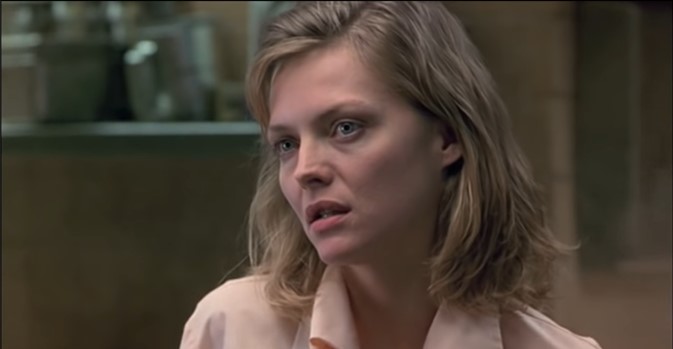
15. Frankie and Johnny (1991)
Part of Michelle Pfeiffer’s screen persona – as malleable as it is – is her beauty. That beauty informs much of her work. So, what happens if she’s cast as a dowdy, frumpy character? Well, it doesn’t really work. This is the main problem with her casting in Garry Marshall’s romantic dramedy Frankie and Johnny. Based on the Terrence McNally stage plays, Frankie and Johnny in the Clair de Lune, the film tells the story of two emotional shut ins who are drawn to each other. The role of Frankie was created on Broadway by Kathy Bates, who a year earlier, terrified audiences with her Oscar-winning portrayal in the horror film Misery. Frankie is a wreck of a human being, having lived a rough life. It’s this sadness that permeates her every move. Pfeiffer – appropriately deglammed – carries Frankie’s sadness in her posture and the way she moves through the scenes, as if that sadness has a perceptible weight. The actress is miscast in the role, but overcomes that miscasting with a very good performance that is endearing.
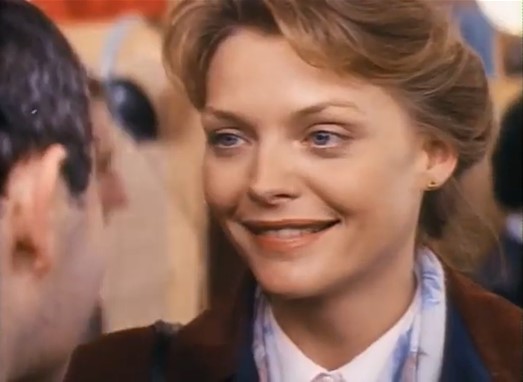
14. The Russia House (1990)
Based on the John le Carré novel, The Russia House is a dated – yet fairly engrossing – drama set in Cold War Soviet Union. Sean Connery, chewing scenery with zeal, plays a British publisher who’s in Moscow on a business trip, but gets yanked into a convoluted – and frankly, sometimes ridiculous – tale of intrigue by the beautiful and mysterious Katya (Pfeiffer), for whom he develops romantic feelings. Films in the 1980s were preoccupied with the Cold War and the Red Scare and there’s a lot of that in this film. (Though, it’s considered one of the first mainstream US films to be filmed on site in Moscow.) Fred Schepisi’s adaptation doesn’t skip any clichés or tropes of the spy film – shadowy figures, tense suspense, pro-Western cheerleading – however, it’s a reasonably entertaining film, mainly because of Connery’s tongue-in-cheek performance and Pfeiffer’s complex work. Sporting a credible Russian accent, Pfeiffer’s Katya is emblematic of the emerging Russia after the Cold War, wary, skittish, yet still idealistic despite extreme adversity.

13. What Lies Beneath (2000)
In M. Night Shyamalan’s 1999 film The Sixth Sense, supporting actors Toni Collette and 10-year-old Haley Joel Osment lent the film gravitas with warm and personable performances, not normally associated with horror films. For their work, both actors were nominated for Oscars. Though she wasn’t nominated for her classy work in What Lies Beneath, what stands out most in this Hitchockian horror thriller is Pfeiffer’s haunted performance. Claire Spencer (Pfeiffer) is a retired cellist, who is dealing with pangs of Empty Nest syndrome after her kid goes off to college. She rambles around a beautiful Cape Cod house with her husband, Norman (Harrison Ford), a local college professor. Though seemingly content, rumblings from the house start to disturb Claire and she starts to believe that she’s being trailed by a spirit. Despite seeing a therapist and performing a séance with her best friend, Jody (a hilariously campy Diana Scarwid), Claire cannot stop seeing apparitions in the house, which prompts her to do some sleuthing which uncovers some tragic truths. Robert Zemeckis is very good at crafting a popcorn horror thriller and What Lies Beneath is a lot of fun, if you don’t try to apply too much logic or reason to the twists and turns. Though Ford is solid, the film rests on Pfeiffer’s shoulders, and she carries it with aplomb.

12. Hairspray (2007)
John Waters’ 1988 comedy was a spiky take on race relations as seen through the drama behind a Baltimore dance competition show on TV. Tracy Turnblad is the winning heroine who defies beauty standards by embracing her plus size and becoming a local star because of her mean dance moves, the support of her friends, and her commitment to equality. Hairspray would be adapted to the Broadway stage in 2002 with music by Marc Shaiman. As in the film, the role of Tracy’s mom, Edna, was played by actors in drag. Originally portrayed by longtime Waters muse Divine in the movie, Harvey Fierstein famously essayed the part in the Broadway version and subsequent productions and tours included the tradition. For the 2007 film adaptation of the musical, the role of Edna was played by John Travolta (in a strangely sweet turn). As the film’s antagonist, Michelle Pfeiffer is a hoot. Her Velma Von Tussle is a dragon of a villain: she’s racist and seizeist, a bully, and cruel to those around her. But Pfeiffer plays the character as campy and ridiculous, defanging her and making her a source of comedy and ridiculous instead of menace or drama. As with her other musical roles, the actress does well with the musical numbers, even getting a nifty solo number “(The Legend) of Miss Baltimore Crabs” which she delivers with a broad Carol Burnett goofiness.

11. Stardust (2007)
Actresses of Michelle Pfeiffer’s generation have mostly avoided the Grand Guignol stage of an actress’ career. For women who faced middle age in the 1960s and 1970s, cheapo horror or sci-fi movies were often the only avenue. For some of these actresses, though, work was work, and pros like Bette Davis managed to find the humour in these dire projects. Michelle Pfeiffer isn’t a mannered actress in the way that Joan Crawford, Bette Davis, or Susan Hayward was. But as she started to move into more mature roles, she found a delicious camp in some of her work, especially in her work in Stardust, Matthew Vaughn’s adaption of the Neil Gaiman novel. As the murderous evil sorceress, Lamia, Pfeiffer is having a ball, blazing through her scenes, chomping through the scenery with a hungry zeal. The film struggles to maintain audience’s attention, as it meanders and is somewhat stodgy, but Pfeiffer’s work in high comedy. Though Pfeiffer is good at playing nice people, she’s even better when playing villains, as it seems to free the actress to just jump in with both feet, and have lots of fun.

10. The Age of Innocence (1993)
Given how successful Pfeiffer’s collaboration with Stephen Frears was in 1988’s Dangerous Liaisons, it makes sense that she comfortably slips into this role, based on the 1920 Edith Wharton novel. Set during the 1870s in New York, The Age of Innocence is a moving story of dissatisfaction, unrequited love, duty and expectations, and cruelty. Pfeiffer is Ellen Olenska, a puzzling target of pity, derision, and ostracization from her social set. Returning from Europe after a terrible marriage and scandalous divorce, Olenska is initially a pariah, but her family stand by her – including her cousin, May Welland (Winona Ryder), who’s engaged to lawyer Newland Archer (Daniel Day-Lewis). Directed by Martin Scorsese, The Age of Innocence follows some of the famed director’s themes of family, loyalty, and consequence in New York society. Pfeiffer’s work as Olenska is impressive – she captures the eccentric, defiant nature of the character as well as the tragic sadness that seems to follow her.
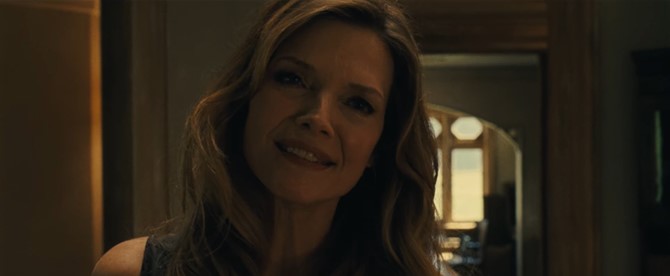
9. mother! (2017)
Darren Aronofsky’s bewildering fantasy mother! has divided critics, still confounding some and angering others. There are some elements of Polanski’s Rosemary’s Baby and even Friedkin’s The Exorcist, in this strange and brutal tale of a young woman (Jennifer Lawrence) whose life is completely turned upside by the arrival of two strangers. mother! is ridiculous and pretentious but also arresting and visually a stunner. It’s a horror film but also a series of beautiful imagery. It’s mad plot and script has some critics enthralled and others hostile. One consistent opinion, however, is the deliciously sly and unnerving performance of Pfeiffer in the film, as the unnamed woman. Though the role is relatively small but she steals the film and makes the biggest impact of the stars with her piercing, dangerous work. She’s so memorable that she even enjoyed some brief Oscar buzz for the film.
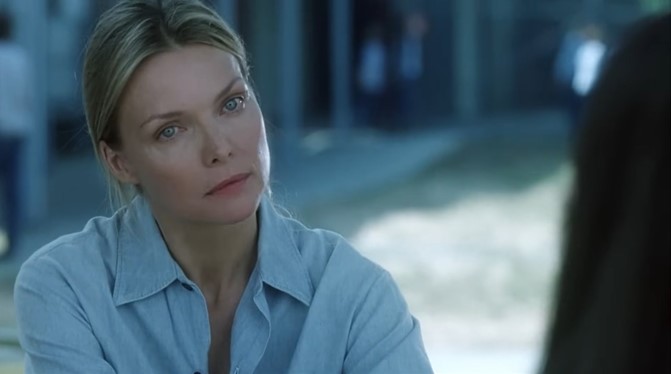
8. White Oleander (2002)
What is so brave about Michelle Pfeiffer’s filmography is that more so than any of her peers, she is willing to play women who are unpleasant, problematic, and despicable. In fact, when she plays villains, she seems to thrive. In this film – based on the Janet Fitch novel – Pfeiffer is Ingrid Mangussen, a beautiful, terrifying woman who murders a lover and is sent to jail. The plot follows Ingrid’s daughter, Astrid (Alison Lohman), as she makes her way through several foster homes while Ingrid languishes in jail. A brilliant poet, Ingrid becomes a folk heroine in a somewhat echo of Charles Manson, and she gains a devoted following, but her success and fandom isn’t enough. She still is intent on controlling her daughter, even from behind bars. The awful relationship between Astrid and Ingrid provides much of the film’s wrenching emotion. In one of the most distressing scenes, Ingrid systematically unravels the fragile reserve of one of Astrid’s sympathetic foster mothers (Renée Zellweger), leading the poor woman to an emotional breakdown. Zellweger’s lovely, doe-like countenance is a devastating contrast to Pfeiffer’s shark-like demeanour. Like her best villain roles, Pfeiffer gives Ingrid a stirring self-regard and megalomania, creating a monster that is so terrifying despite being locked away in a jail cell.

7. Love Field (1992)
Pfeiffer’s superlative work notwithstanding, this dreary civil rights drama is Oscar bait at its most cynical. Directed by Jonathan Kaplan and written by Don Roos, Love Field tells the story of Lurene Hallett, a 60s Dallas housewife and beautician who is obsessed with Jackie Kennedy. So much so, that she dresses like the First Lady. Inspired by the 1963 assassination of President Kennedy, Lurenne sets off to Washington, DC to attend the funeral. On the way, she meets the stoic Paul Carter (Dennis Haysbert) and his cautious little daughter, Jonell (Stephanie McFadden). After a disastrous misunderstanding, the three are on the lam, and the film becomes a confused road trip. To its credit, Roos’ script rarely shies away from depicting the ugly racism of the time, nor does he make his heroine an anachronistic ally. However, the film shifts focus on Civil Rights Movement from Black Americans’ experiences to that of this silly white lady. And, oh my god, is Lurene ridiculous. Pfeiffer’s work is brilliant and wonderful – she brings a humanity, depth, and dignity to the character. However, it’s unclear why we’re watching this disaster of a human being in the first place. For her work, she was rightly nominated for her third (and to date, last, Oscar nomination), but the movie is trite, offensive nonsense.

Paladin
6. Where Is Kyra? (2017)
Pfeiffer’s broke another pause in her career in the mid-2010s with a series of films, both small and blockbuster. The larger films were largely supporting roles and the indie movies gave Pfeiffer chances to be the star. In the strange Where Is Kyra?, Pfeiffer plays a rootless drifter who cannot seem to keep her shit together. It’s a character study more than anything about a woman who is flirting with homelessness as she’s incapable of taking care of herself, after losing the only meagre source of income she had: her sickly mother’s benefits. Pfeiffer’s Kyra is a complex and confounding creature, one who is self-destructive and maddening. She moves around a cruel and cold New York City which is indifferent to her suffering and struggles. It’s a bleak and miserable film, but Pfeiffer’s work is truly astounding. Her movie star glamour is all but complete obliterated; and though her stupendous beauty is still there – it doesn’t ameliorate any of the indignities her character has to face.

5. French Exit (2020)
Azazel Jacob’s comedy French Exit (based on the novel by Patrick deWitt) is a lean, light film but it boasts a fantastic performance by Pfeiffer. By 2020, Pfeiffer was seemingly content in her current career as character actress, no longer headlining blockbuster films. Small films like this one are so enjoyable because they show audiences just what an exciting and vibrant performance Michelle Pfeiffer is. As the haughty and delusional society matron, Frances Price, Pfeiffer is at once, hilarious and moving. Frances isn’t necessarily a likable character – she’s entitled, prickly, and vinegary – but in Pfeiffer’s skilled hands, Frances is still absorbing character to watch. Despite being a woman of reduced circumstances, there’s a persisting endurance to her. Yet again, Pfeiffer shows her knack for deadpan comedy and her timing is undimmed. There is a dark Auntie Mame quality to her characterisation in the film but she never makes the eccentricities of Frances a cartoon or caricature.

4. Dangerous Liaisons (1988)
Pfeiffer’s star would rise in the 1980s as she started to show her considerable acting chops. Period drama seemed especially well suited to her ethereal beauty and intense acting. As the naïve and tragic Madame de Tourvel, Pfeiffer manages to embody virtue and reserve. Tourvel is an unwitting pawn in the cruel games of Valmont (John Malkovich) and Merteuil (Glenn Close), yet her innate goodness and humanity endears her to the former, complicated the disastrous trio. Pfeiffer is simply luminous in the role – a difficult character to play because a lesser actress would be dull and wan as the reserved Tourvel. At this point, Pfeiffer has developed an acting technique in conveying a wide range of emotions that barely register on her beautiful face. It’s an acting style of grace and economy, yet can be devastating when that seemingly placid visage starts to subtly curdle in pain or regret. For her efforts in Stephen Frears’ adaptation of the Pierre Choderlos de Laclos novel, Pfeiffer was nominated for an Academy Award for the first time and won a BAFTA.

3. Married to the Mob (1988)
It seems unfair that a woman who looks like Michelle Pfeiffer could also be funny. The late great Joan Rivers once quipped “When you go on stage as a woman comedian, you cannot go on as a sex symbol. They’re not going to laugh at you.” As the beleaguered and endangered mafia wife, Angela de Marco, Pfeiffer is hilarious. In arguably her greatest comedic performances (and one of her most accomplished), the actress proves to be a consummate screen comedienne. Jonathan Demme does something quite novel with the mafia movie genre by making it a broad, slapstick comedy. It’s a high-pitched, over the top exercise in absurdity, but Pfeiffer finds the core of heart and humanity, turning the funny Angela into a vulnerable, appealing human being. Married to the Mob is an odd film with screwy oddball characters populated the film, yet Pfeiffer doesn’t slip into the dull ‘straight man’ role despite the normalcy of her character. In fact, she’s a real comedic force, owning every scene she’s in.

2. Batman Returns (1992)
As strange is it seems now, Michelle Pfeiffer was not the first choice to play Catwoman in Tim Burton’s twisted gothic take on the superhero character. Some of Hollywood’s brightest stars were considered, with Annette Bening eventually winning the role, having to bow out when she became pregnant. Pfeiffer was ultimately cast, and no it seems inconceivable that any other actress could have done what she did with Catwoman. Burton’s vision of the Batman lore has dark, psychological themes laced through the boffo action scenes. Pfeiffer’s Catwoman is no longer just the dashing jewel thief familiar to audiences from the campy ’60s show. Instead, Catwoman is an embittered, abused victim of sexism and misogyny. She responds to the world’s disregard of her humanity, by turning on it, becoming a feminist vigilante. Pfeiffer’s Catwoman is witty and mordantly funny, and kicks some ass. There’s also an emotional range in Pfeiffer’s performance, as Catwoman’s complexities and humanity seem to clash with her thirst for vengeance.

1. The Fabulous Baker Boys (1989)
One thing that Steve Kloves’ musical comedy-drama proved is that along with being a great actress, Michelle Pfeiffer was a great movie star. Perhaps the greatest. Being a movie star and being an actress are two different things: a movie star is more than just a talented thespian, but a performer with than undefinable it. And in The Fabulous Baker Boys, Pfeiffer has it. Lots of it. Channelling the cool beauties of Hollywood like Rita Hayworth and Lauren Bacall, Pfeiffer is sex incarnate as the sulty lounge singer, Suzie Diamond. The titular piano bar act hires Suzie to enliven their performances, yet proves to be their undoing. The film is a dreamy, glossy 80s trifle that would float away to nothing if not for Pfeiffer’s superlative work. She not only is sensual and ravishing, but she also does her own singing, never wowing audiences with a hidden talent, but instead, ingratiating her way with her masterful phrasing. In the annals of classic film scenes of the 1980s, Pfeiffer – clad in a slinky red dress – crooning “Makin’ Whoopee” on a piano has become iconic. For her work, Pfeiffer dominated the award season in 1989, winning most of the critics’ awards, and earning her second Oscar nomination.

Michelle Pfeiffer
LikeLike
Michelle Pfeiffer was great in the Russia House and if you enjoyed that and enjoy reading fact based espionage thrillers, of which there are only a handful of decent ones, do try reading Bill Fairclough’s Beyond Enkription. It is an enthralling unadulterated fact based autobiographical spy thriller and a super read as long as you don’t expect John le Carré’s delicate diction, sophisticated syntax and placid plots.
What is interesting is that this book is so different to any other espionage thrillers fact or fiction that I have ever read. It is extraordinarily memorable and unsurprisingly apparently mandatory reading in some countries’ intelligence agencies’ induction programs. Why?
Maybe because the book has been heralded by those who should know as “being up there with My Silent War by Kim Philby and No Other Choice by George Blake”; maybe because Bill Fairclough (the author) deviously dissects unusual topics, for example, by using real situations relating to how much agents are kept in the dark by their spy-masters and (surprisingly) vice versa; and/or maybe because he has survived literally dozens of death defying experiences including 20 plus attempted murders.
The action in Beyond Enkription is set in 1974 about a real maverick British accountant who worked in Coopers & Lybrand (now PwC) in London, Nassau, Miami and Port au Prince. Initially in 1974 he unwittingly worked for MI5 and MI6 based in London infiltrating an organised crime gang. Later he worked knowingly for the CIA in the Americas. In subsequent books yet to be published (when employed by Citicorp, Barclays, Reuters and others) he continued to work for several intelligence agencies. Fairclough has been justifiably likened to a posh version of Harry Palmer aka Michael Caine in the films based on Len Deighton’s spy novels.
Beyond Enkription is a must read for espionage cognoscenti. Whatever you do, you must read some of the latest news articles (since August 2021) in TheBurlingtonFiles website before taking the plunge and getting stuck into Beyond Enkription. You’ll soon be immersed in a whole new world which you won’t want to exit. Intriguingly, the articles were released seven or more years after the book was published. TheBurlingtonFiles website itself is well worth a visit and don’t miss the articles about FaireSansDire. The website is a bit like a virtual espionage museum and refreshingly advert free.
Returning to the intense and electrifying thriller Beyond Enkription, it has had mainly five star reviews so don’t be put off by Chapter 1 if you are squeamish. You can always skip through the squeamish bits and just get the gist of what is going on in the first chapter. Mind you, infiltrating international state sponsored people and body part smuggling mobs isn’t a job for the squeamish! Thereafter don’t skip any of the text or you’ll lose the plots. The book is ever increasingly cerebral albeit pacy and action packed. Indeed, the twists and turns in the interwoven plots kept me guessing beyond the epilogue even on my second reading.
The characters were wholesome, well-developed and beguiling to the extent that you’ll probably end up loving those you hated ab initio, particularly Sara Burlington. The attention to detail added extra layers of authenticity to the narrative and above all else you can’t escape the realism. Unlike reading most spy thrillers, you will soon realise it actually happened but don’t trust a soul.
LikeLike